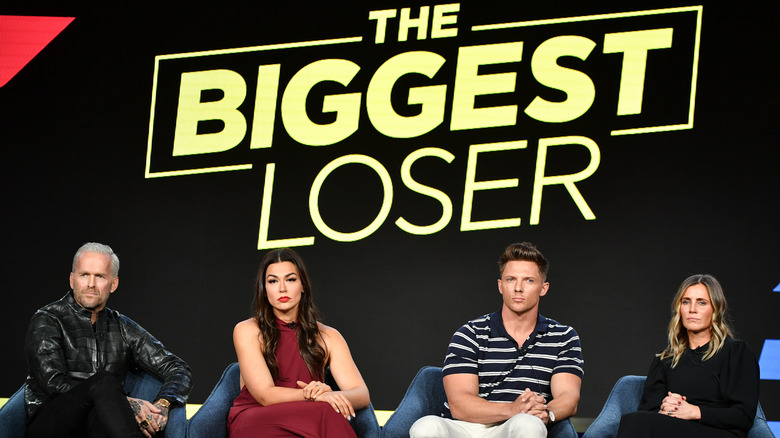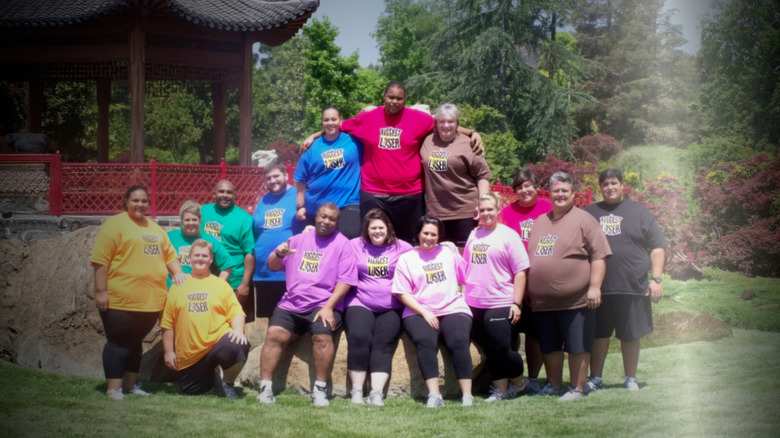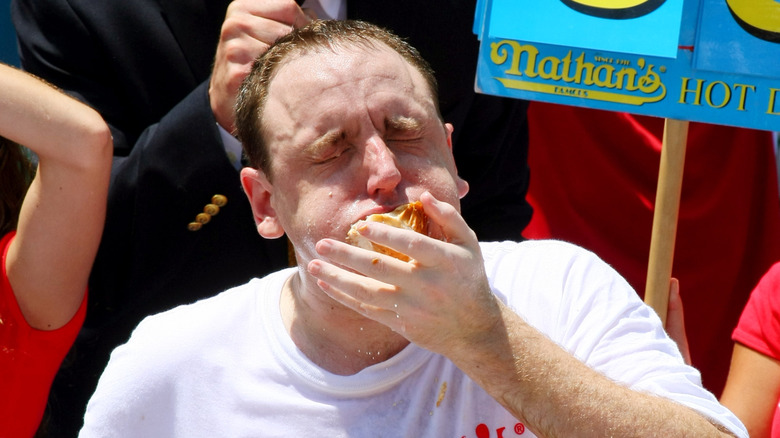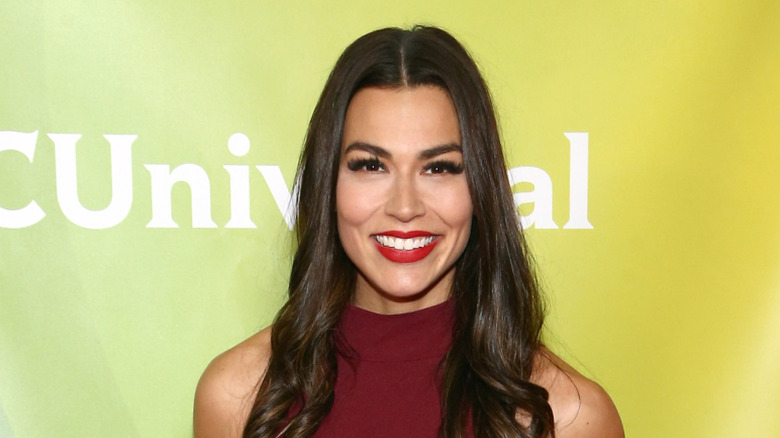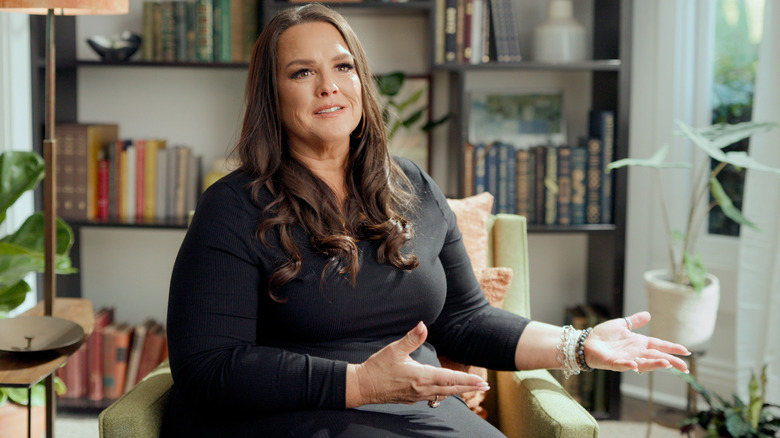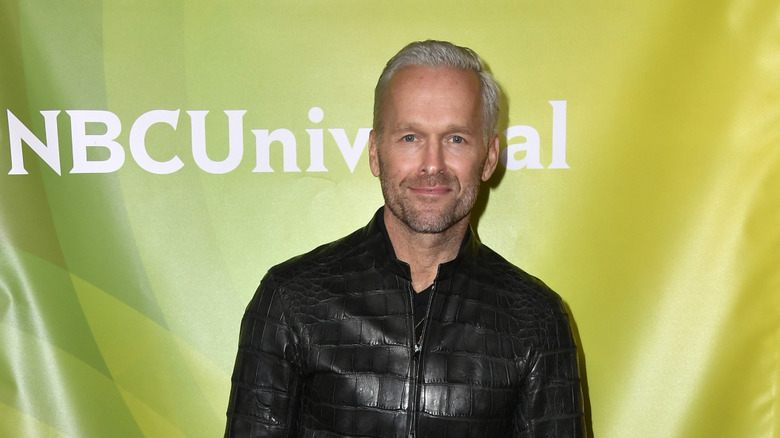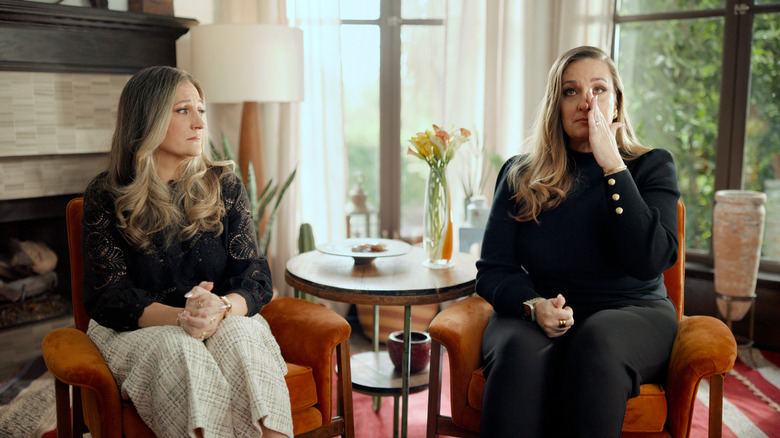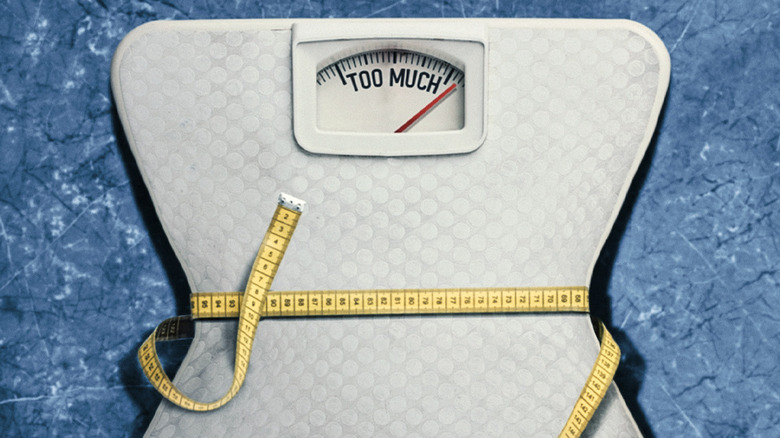The Biggest Loser Was Way More Cringe Than You Remember
When Netflix aired "Fit for TV," a three-episode docuseries about the untold truth of "The Biggest Loser," audiences were forced to reckon with the fact that this reality TV show was more cringe than they likely remembered. Of course, there were warning signs from the very beginning, with critics immediately calling out "The Biggest Loser" for being emotionally manipulative and downright cruel. At the time of its 2004 debut, Dana Stevens of Slate wrote, "[The series] capitalizes on Americans' fear and hatred of their bodies, making the differently sized the stars of a freak show," while Andrew Ryan of The Globe and Mail declared, "This could be the lowest-rung TV format ever devised." Nonetheless, viewers lapped it up.
In a review for "Fit for TV," The Guardian plainly asks, "How did television ever sink so low?" "The Biggest Loser" attempts to obfuscate its mean-spiritedness by masquerading as "inspirational," but make no mistake – the cruelty was the selling point, and boy, did this show sell. "The Biggest Loser" was a massive winner, sometimes drawing more than 10 million viewers and reportedly earning over $96 million a year in ad revenue alone, according to Fast Company. That's not even including the massive amount of merchandise and multimedia offshoots of the series, from workout DVDs to cookbooks. After two decades and countless controversies, though, "The Biggest Loser" carries almost wholly negative connotations. With the benefit of hindsight, audiences are realizing this was a much nastier show than they remember.
A body-shaming relic of the past
Revisiting "The Biggest Loser" today reminds one that it's from a different, less sensitive time. Alongside "Flab to Fab," "Celebrity Fit Club," and "Fat Families," the show existed at a time when exploitative weight-loss reality series were beginning to grip the cultural zeitgeist. This insensitive, weight-shaming subgenre peaked around 2010 with an all-you-can-watch buffet of gross TV shows, including "My 600-lb Life," "I Used to Be Huge," "Money Hungry," "Bulging Brides," "Fat Chef," "Kirstie Alley's Big Life," "Extreme Weight Loss," and "Heavily Ever After." These shows are fundamentally about fat-shaming, and "The Biggest Loser" was the bloated behemoth beating them all.
"There's a loathsome, mock-the-fatty undertow to Biggest Loser," wrote Gillian Flynn in her piece on the show for Entertainment Weekly. "I almost think the show is some sick way of just mocking people who have obesity," Dr. Scott Butsch, a Harvard Medical School instructor, told The Cut in 2016, the year society finally woke up to "The Biggest Loser." That's partially thanks to that year's landmark study from the National Institute of Diabetes and Digestive and Kidney Diseases, which followed contestants of "The Biggest Loser" for six years and concluded that the series was severely detrimental to their health, ruining their resting metabolism and resulting in significant weight gain. The series was canceled that year as the cultural conversation about diet, weight, and health became more empathetic. Watching "The Biggest Loser" today reminds us of how cringeworthy our perception of weight loss was.
Those cruel binge-eating challenges
The weight-shaming aspect of "The Biggest Loser" is exemplified by the challenges and contests in each episode. As Gillian Flynn wrote in her aforementioned Entertainment Weekly piece, "These contests seem to be mean-spirited attention-getting ploys [...] the gimmick is more cruel than clever." Challenges forced contestants into embarrassing situations, like building a tower of pastries using only their mouths or running through humiliating obstacle courses.
Aside from the multiple hours of vomit-inducing exercise the contestants were subjected to each day (on a dangerously low caloric intake), perhaps the cruelest activities on "The Biggest Loser" involved the so-called "temptation challenges." These were counterintuitive opportunities for contestants to gain a competitive advantage (or a personal benefit, like calling their family), but only if they engaged in binge eating. One temptation challenge rewarded the winner with control of the elimination round, but only if they ate the most calories; the winner consumed more than 4,100 calories in one sitting. The intrusive camerawork and manipulative editing make the contestants look ridiculous while they eat, as in one Valentine's Day episode where contestants ate as much as possible in complete darkness.
"The temptation challenges were the hardest part of the show for me. It was horrible," said former host Alison Sweeney in "Fit for TV." Bob Harper, one of the show's trainers, called them "so dumb." That certainly didn't stop them from going along with the challenges and cashing their checks.
A buffet of product placement
Speaking of cashing checks, re-watching "The Biggest Loser" feels like being consumed by a giant commercial. The show's extreme profitability was thanks to its cozy relationship with corporate partners. As CNBC reports, it featured 533 product placements during just 34 episodes in 2011. "The Biggest Loser" took advantage of its two-hour runtime by including cringy infomercials. These often took the form of "trainer tips," which featured one or more trainers shilling for brands like Ziploc, Extra, Progresso, and other products.
Contestants of the show also went on "field trips," which were just excuses to integrate product placement into the series' challenges. These included 24 Hour Fitness Gyms, where the contestants competed in treadmill and other challenges, and Subway, where contestants competed to create their own version of a "healthy" Subway sandwich. These days, when people pay for streaming services with limited or no commercials, the constant advertising on display in "The Biggest Loser" is downright awkward. Skipping these infomercials and commercials, a two-hour episode quickly turns to just 40 minutes.
"The Biggest Loser" didn't just promote sponsors' products; they practically force-fed them to the contestants. Season 3 contestant Kai Hibbard told The New York Post that much of her food was provided by sponsors despite the lack of nutritional benefits. "My season had a lot of Franken-foods," she said, "I Can't Believe It's Not Butter spray, Kraft fat-free cheese, Rockstar Energy Drinks, Jell-O."
An unhealthy relationship with Subway
Of the many products and sponsors associated with "The Biggest Loser," the food chain Subway had the most extensive relationship with the show. Looking back now, that's cringe-worthy for a couple of crucial reasons. First, it's incredibly uncomfortable to see former Subway spokesperson and convicted pedophile Jared Fogle appear on "The Biggest Loser," showing up in S14 to announce that the winner will film a Subway commercial with him. While "The Biggest Loser" team likely didn't know about Fogle's abusive history with children (unlike Subway, which probably did), it's nonetheless upsetting to revisit.
Next, it's patently ridiculous for a weight-loss show to be so closely associated with Subway, which was exposed for being misleadingly unhealthy. UCLA Health found "there was no statistically significant difference between" Subway and McDonald's, despite the former's branding as a healthier alternative. Due to more restrictive food labeling laws in other countries, Ireland's Supreme Court has ruled that "the bread in Subway's heated sandwiches has too much sugar in it to meet the legal definition of being bread," according to The Irish Independent. In fact, it contains five times the amount of sugar permitted by Ireland's Value-Added Tax Act of 1972. The HBO series "Last Week Tonight with John Oliver" devoted an entire episode to exposing the many problems with Subway. The episode garnered 12 million views on YouTube alone. Count that as a loss for "The Biggest Loser."
Starving winners and eating disorders
While contestants had an unhealthy relationship with food before appearing on "The Biggest Loser," they certainly had an unhealthy relationship with it while on the show. Alongside the binge-eating from temptation challenges and the sponsors' Franken-food products, the contestants also practiced outright starvation. S1 winner Ryan Benson opened up to People in 2024 about spending 10 days consuming only lemon juice, maple syrup, and cayenne pepper, all while exercising constantly. "Doctors tested our urine the day of our last weigh-in, and they told me there was blood in mine because I was so dehydrated," Benson said. "Within three days after the show, I had gained 25 to 30 pounds back just in water weight alone." It wasn't long before he was back to 300 pounds.
Suzy Mendonca, who appeared in S2 of the show, has also spoken about the show's warped use of food. In "Fit for TV," Mendonca stated, "I didn't know who I was financially, emotionally, mentally, physically. You know, I came back with a severe eating disorder. I stopped eating." Even one of the show's trainers, Erica Lugo, had an eating disorder while on the show. "I was mentally and emotionally miserable," Lugo wrote in an Instagram post. "I would sit in the bathroom while filming and cry. Cry for hours [because] the eating disorder thoughts kept telling me 'just purge, it'll help keep you thin.'"
The contestant who claims she died
The most unhealthy feature of "The Biggest Loser" was undoubtedly its extreme exercise routines, which can last six or more hours and had contestants fainting, sobbing, and vomiting. The S8 premiere is perhaps the simplest but most representative example of this. It thrust its contestants into a one-mile run on the beach on the very first day of filming, and resulted in the collapse of two people.
One of them, Tracey Yukich, couldn't complete the mile and was pulled by fellow contestants to the finishing line. When it became evident that Yukich was experiencing something more than exhaustion, she was airlifted to the hospital. In "Fit for TV," Yukich recounts having a near-death experience, saying, "I just felt like I was floating. And then my grandpa was there. And then I saw darkness. But then I saw light. So I knew, I knew I died that day." It turns out she'd developed rhabdomyolysis, a condition that disintegrates the muscles and releases their toxic fibers into the bloodstream and kidneys.
Yukich continued to compete despite medical recommendations. She did so in a limited capacity, something which irked trainers Bob Harper and Jillian Michaels, who complained about Yukich throughout the season. They became the targets of viewers' ire after "Fit for TV" aired, with one X user writing, "Bob and Jillian were crazy. One contestant almost died, and Jillian and Bob were pissed she was listening to the doctor instead of exercising. SHE ALMOST DIED!"
Bob Harper took things too far
The treatment of Tracey Yukich was not the only time the "The Biggest Loser" trainers behaved inappropriately. In fact, they were often surprisingly abusive, shouting horrific things at contestants and frequently forcing them to do exercises which doctors warned them against. Aside from incidents involving Jillian Michaels (whose nightmarish behavior we'll get to momentarily), one of the most egregious examples involved trainer Bob Harper and S7 contestant Joelle Gwynn.
Contestants were doing intense intervals on a treadmill in the infamous episode, and Harper didn't appreciate Gwynn's efforts compared to the rest of the team. After berating her for a bit, he shouted, "What the f***, Joelle? Every single time at 20 seconds, every time, what is it? Everyone goes for 30 seconds. You don't come off for 30 seconds, okay? That's all I'm asking, just do that. God!"
Eventually, exhausted and upset, Gwynn yelled (via People), ""I'm not trying to quit!" Harper exploded back at her, ""Well then do it, Joelle! Stop saying all these words. Quit talking! I'm sick of just words, words, words, talk, talk, talk! Shut the f*** up, just do it! Just stop talking and do it!" Gwynn summed it up in the "Fit for TV" docuseries: "That little country bumpkin of a man berates me in such a way I've never seen on the show before." Harper admitted in the Netflix show, "It wasn't one of my proudest moments."
Jillian Michaels' disturbing behavior
While other trainers certainly had their issues, Jillian Michaels' shady treatment of "The Biggest Loser" contestants takes the cake. It was bad to watch when the show first aired, and it's even worse today, knowing more of MAGA Michaels' opinions, such as on slavery. "You cannot tie imperialism and racism and slavery to just one race," Michaels said on CNN on August 14 (via People). "Do you realize that only less than 2% of White Americans owned slaves?" That's hardly the first time Michaels has been defiantly insulting, with her "Biggest Loser" tenure featuring the show's angriest outbursts.
"Unless you faint, puke or die, keep walking!" she yelled in the gym. "I don't care if people die on this floor. You better die looking good," she shouted in one episode, screaming in another, "If you don't run I will pull Alex on the floor and I will break every bone in his body!" Other Jillian gems include: "I'm proud that I made him vomit," "I don't care if one of your legs fall off or if one of your lungs explode," and "It's fun watching other people suffer like that."
Michaels didn't seem to treat other trainers any better than the contestants on "The Biggest Loser," either. Bob Harper has said that Michaels never reached out to him after he suffered a 'widowmaker' heart attack, telling The Guardian, "I would not expect Jillian Michaels to do anything other than what she wants to do."
The caffeine pill scandal and Jillian Michael's exit
While Jillian Michaels' onslaught of insults should've been enough to warrant concern, the trainer would continue to rant and rave through S15. That's when a scandal erupted involving caffeine pills she is said to have given to her team, which "The Biggest Loser" team claimed were banned from the competition. "There is something important that needs to be addressed," said host Alison Sweeney at the time (per Today). "Last week, Jillian broke the rules and gave caffeine supplements to each member of her team without doctor's permission." Michaels remained stubborn as usual, saying, "I stand by my opinion, a caffeine supplement is significantly healthier than unlimited amounts of coffee."
Apparently, Michaels didn't appreciate how the "Fit for TV" docuseries depicted her. However, she refused to participate in the series to tell her side. She has been apoplectically posting emails and text messages from the time on Instagram, alleging that she is being lied about. On August 19, 2025, four days after the documentary was released on Netflix, Michaels reached out to TMZ, stating she intended to sue Netflix, Bob Harper, and Dr. Robert Huizenga, a former team physician on "The Biggest Loser."
"Caffeine, a weight loss pill, was absolutely against everything in the show," Huizenga said in the Netflix docuseries. "It was in the show rules, and the patients signed off to that and the trainers signed off to that, and all the producers signed off to that."
Manipulative editing leads to death threats
As if the show's trainers and dietary restrictions weren't bad enough, re-watching "The Biggest Loser" in hindsight reveals just how deceptive and totally fake the editing was on the show. Heather Hansen of S3 is a prime example of reality TV manipulation. She was made out to be lazy and combative when refusing certain challenges or working slower than others, when in fact she had developed bursitis in her knees and tendonitis in her quadriceps, not to mention a torn calf muscle. "You get a lot of pressure from the trainers to push your body beyond its limits," Hansen told Deseret News. "The doctor would say, 'Don't do squats, hills or inclines,' but then the trainer would say, 'We're climbing up a sand hill today.'"
"That is the mighty power of the television editor," wrote "The Biggest Loser" contestant Kai Hibbard for Cracked. "With enough time and a copy of Adobe Premiere, you can make Mr. Rogers look like a blood-drinking psychopath." She referred to Hansen as "one of the kindest individuals I have ever met in my life," but revealed, "Because she didn't comply, they edited the footage to make her look like the biggest b**** in the world. ... She got so many death threats that NBC had to disable the messaging function on her part of the show's site. All because she had been injured the previous week and physically could not do what they were asking."
The Biggest Loser loses too much with Rachel Frederickson
There were countless jaw-dropping and unhealthy weight-loss journeys throughout "The Biggest Loser." S9 winner Michael Ventrella lost a disturbing 264 pounds during his time on the show, while S7 runner-up Tara Costa lost more than 50% of her body weight, shedding 155 pounds. However, one contestant's transformation startled not just audience members but even the trainers, who recall being "horrified" when they saw poor Rachel Frederickson after she dropped from 260 pounds to just 105 pounds. "Rachel's 60 percent weight loss is nothing to celebrate. Biggest loser should be ashamed," wrote one X user at the time (per The Mercury News), with others mocking Frederickson. A commenter on Entertainment Weekly wrote, "This made me so sad. Rachel looked beautiful at 150 pounds. I expected her to end up in the 120s. The girl who came out last night looked frail and sick, not like an athlete."
Frederickson's weight loss exemplifies the greatest problems with "The Biggest Loser," while also revealing the hypocrisy and misogyny of body image standards (fat or thin, you can't win). The weight-loss series pushed an extreme view of dieting and exercise that is just downright unhealthy, evidenced by the sad fate of its contestants and the horror stories of "Fit for TV." In reality, doctors recommend losing no more than two pounds per week, but that's not exciting enough for TV producers. Then again, maybe weight loss shouldn't be a spectator sport.

